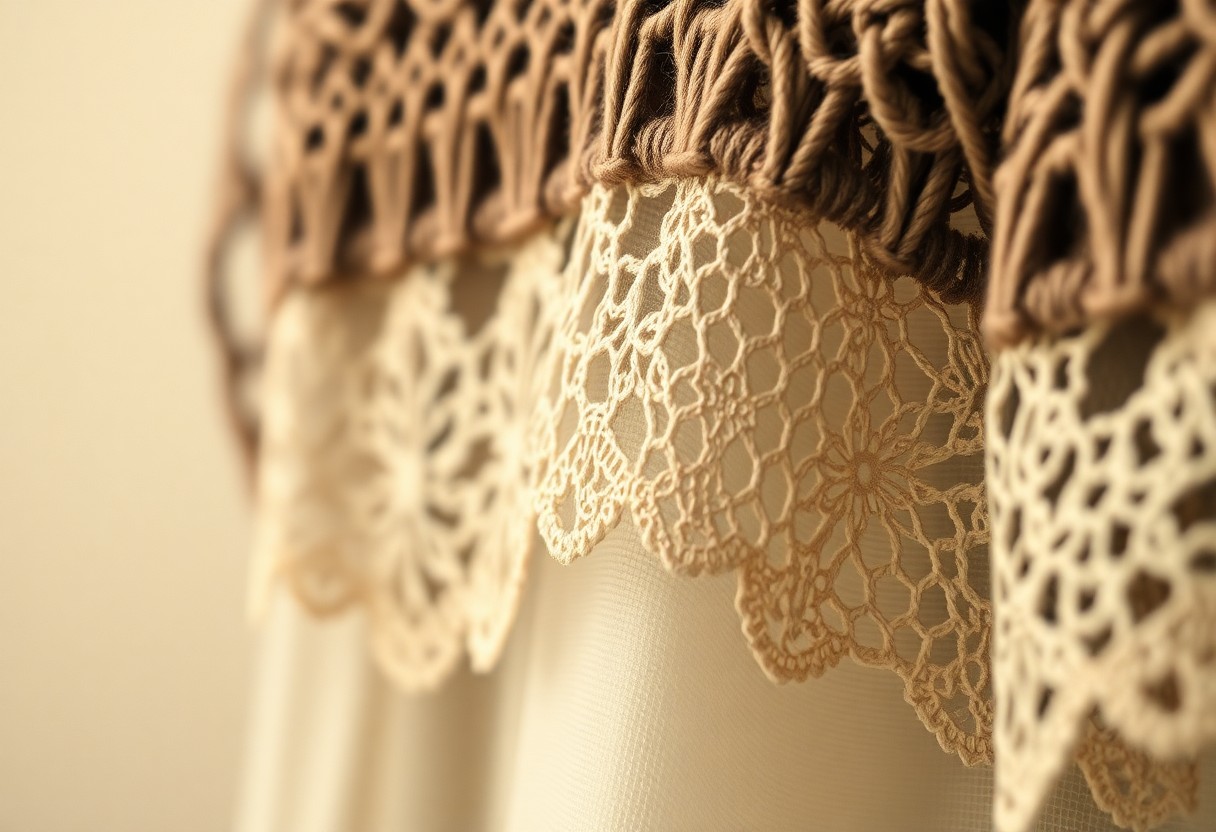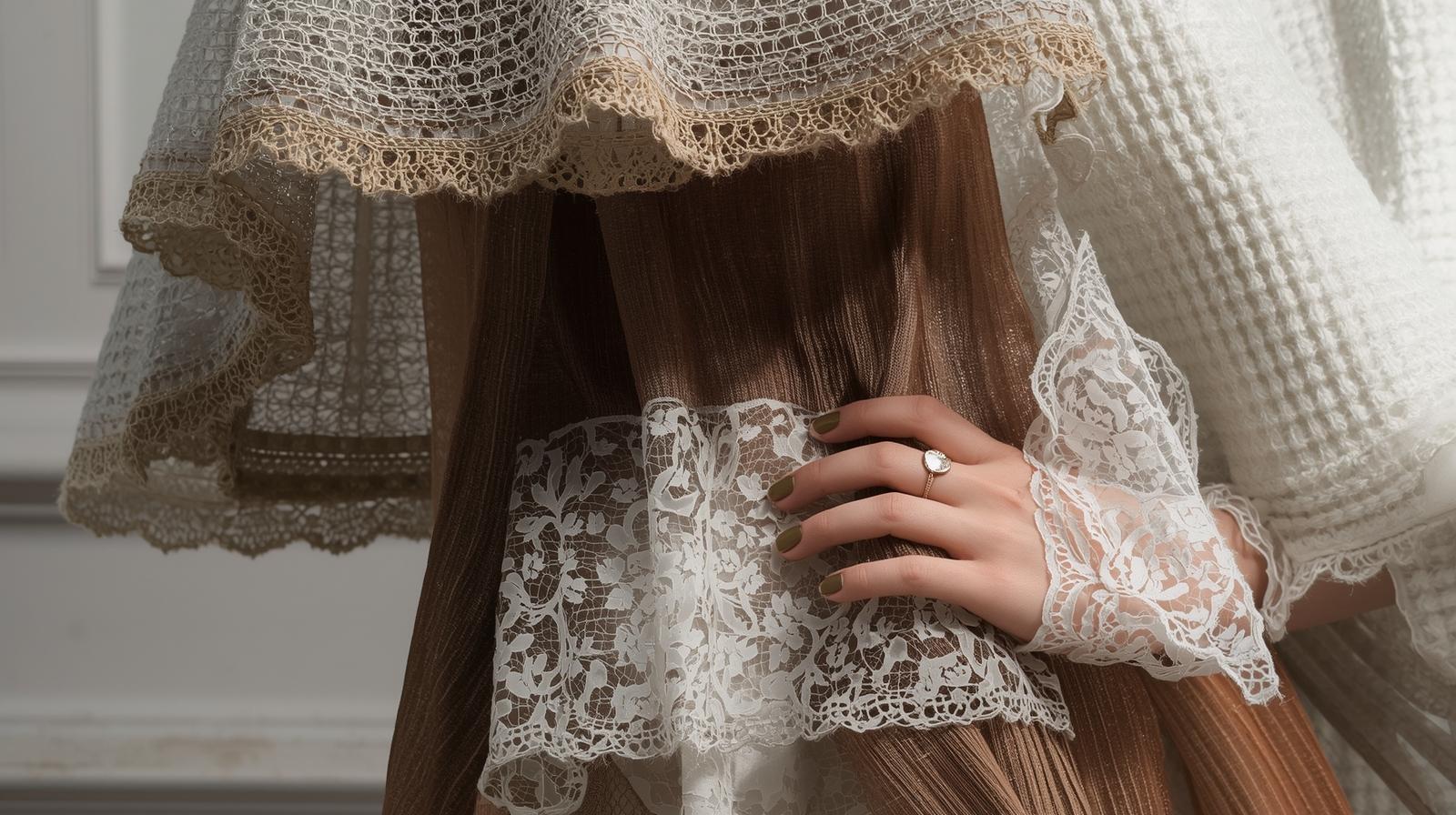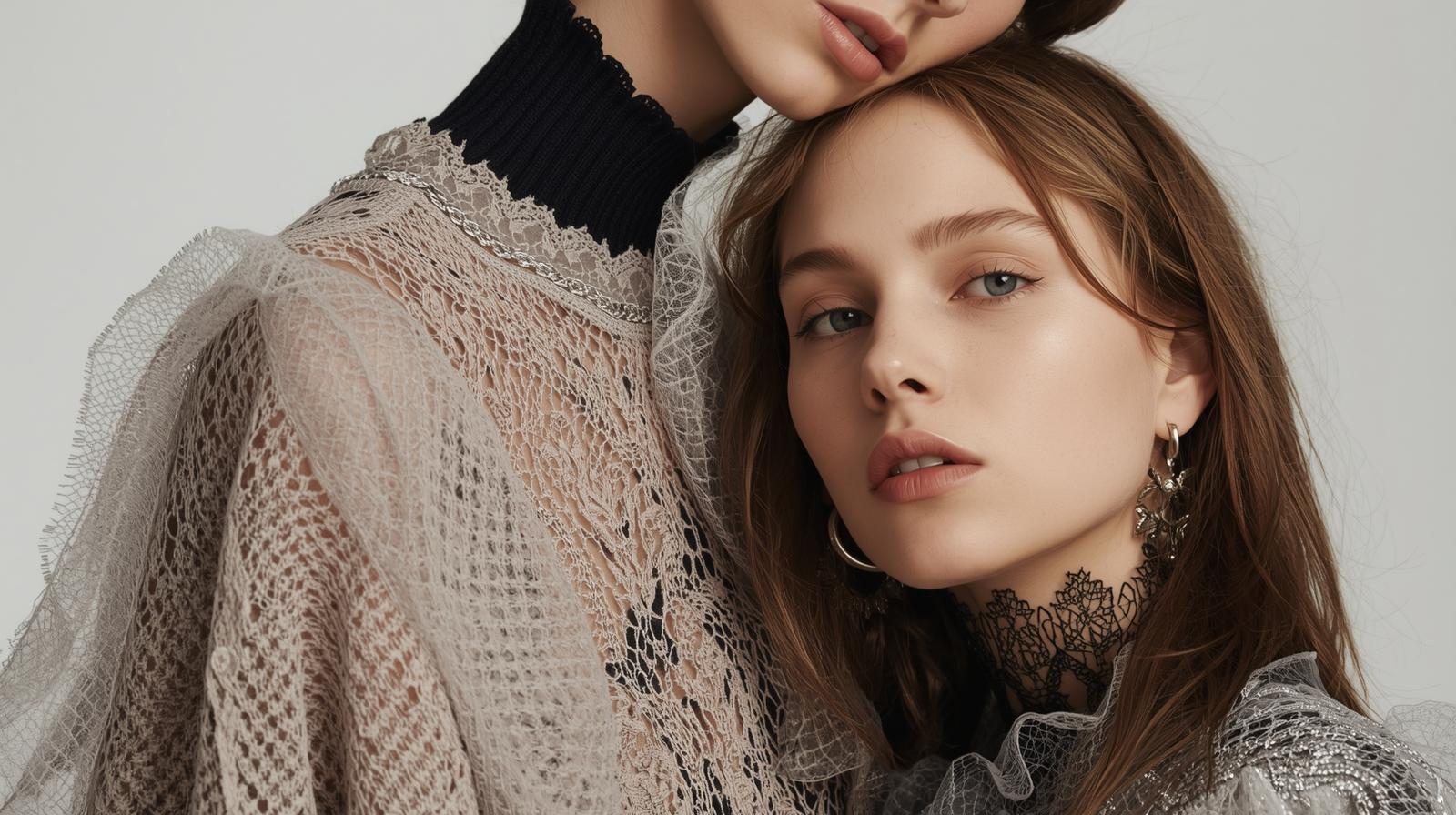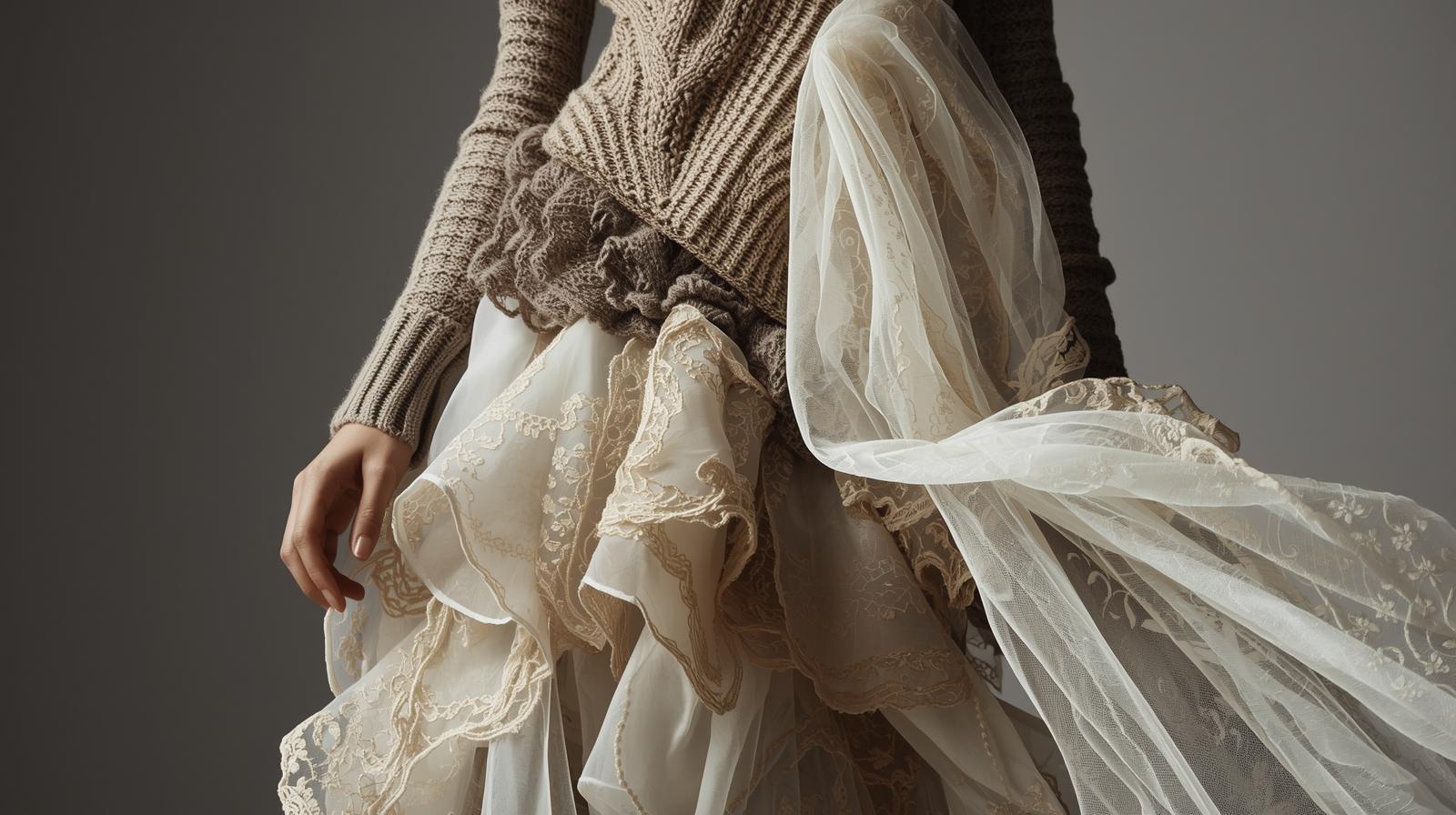8th Oct 2025
Texture Layering Mastery - Knits, Lace & Sheer Combined

Over time, mastering texture layering enhances your style and elevates your wardrobe. By combining knits, lace, and sheer fabrics, you can create visually captivating outfits that showcase your personal flair. This guide will help you navigate the art of layering, ensuring that each piece complements rather than competes with the others. Embrace these textures to add depth and interest to your ensembles, transforming the ordinary into extraordinary while maintaining a polished look.
Understanding Texture in Textiles
Texture in textiles shapes the overall aesthetic and functional quality of fabrics. It influences how garments drape, fit, and interact with light, while also impacting comfort and appeal. When exploring texture, you enhance your design vocabulary, allowing for more creative expression in your projects and helping to achieve the desired look and feel in your work.
The Importance of Texture
In fashion design, texture serves as a primary tool for conveying emotion and style. Varied textures can evoke feelings of warmth, sophistication, or playfulness, significantly impacting your audience's perception. Harmonizing different textures in your designs breathes life into garments, enhancing their visual richness and depth, ultimately engaging the observer.
Types of Textures
Textures can be categorized into several types, each contributing unique attributes to textiles. Woven, knitted, felted, non-woven, and finished textures represent the major classifications, defined by the methods of production and material characteristics. Exploring these types allows you to select the right texture according to the desired style and functionality.
| Type | Description |
| Woven | The weave is created by interlacing threads perpendicular to each other. |
| Knitted | Made from interlocking loops of yarn, it offers stretch. |
| Felted | Produced by matting fibres together through heat and moisture. |
| Nonwoven | The fibres are bonded together without the need for weaving or knitting, much like felt. |
| Finished | Altered surface texture through processes like printing or dyeing. |
A comprehensive understanding of these texture types enables you to select materials that not only meet aesthetic desires but also provide the necessary structure and resilience in your creations. Each texture type has its own unique benefits and drawbacks that can influence the outcome of your designs.
- Woven —interlaced threads for strength.
- Knitted—Offers elasticity and comfort.
- Felted —unique texture and warmth.
- Non-woven—Versatile and easy to manipulate.
- Finished—enhances surface aesthetics.
Any exploration of these textures will deepen your understanding and appreciation for the role of texture in your textile projects, guiding you to make informed design choices.

The Art of Knitting
Knitting is not just a craft; it’s a blend of art and science that allows you to create intricate textures and patterns. As you explore different methods, you’ll find how knitting can transform yarn into a versatile medium for fashion, home decor, and art pieces. Mastery comes from experimenting with various stitches and techniques, enabling your creativity to flourish.
Basic Knitting Techniques
Fundamental knitting techniques lay the groundwork for more complex designs. You need to learn the core actions: casting on, the knit and purl stitches, and binding off. With practice, you will achieve a solid foundation that empowers you to approach intricate projects confidently.
Advanced Knitting Patterns
Exploring advanced knitting patterns exposes you to a vast realm of intricacy. Mastery of techniques such as colorwork, lace, and cables allows you to create visually stunning pieces. Patterns often utilize advanced stitches that offer texture and depth, pushing the boundaries of traditional knitting.
Advanced Knitting Patterns Overview
| Pattern Type | Description |
| Colorwork | Incorporates multiple colours to create designs, like Fair Isle or intarsia. |
| Lace Knitting | Utilizes yarn overs and decreases to create airy, delicate fabrics. |
| Cables | Involves twisting stitches to create raised patterns resembling braids. |
| Textured Stitches | Includes various techniques, like seed stitch or popcorn stitch for added dimension. |
Advanced knitting patterns enhance your skill set and expand your creative possibilities. Engaging with these patterns means understanding how stitches interact, which enhances your ability to manipulate fabric. Pairing colorwork with texture or combining lace with cables creates layers of beauty and complexity in your work. The satisfaction derived from mastering such advanced techniques is immeasurable.
- Experimentation with different fibres can yield unique results.
- Note the gauge; it affects the pattern's final appearance.
- Use stitch markers to manage complicated patterns effectively.
- Practice blocking your finished pieces to enhance their texture.

Advanced Techniques Summary
| Technique | Benefits |
| Stranded Knitting | The technique allows for the creation of intricate designs and patterns within your fabric. |
| Shaping Techniques | Allows for tailored and fitted garments. |
| Short Rows | Enhances your ability to create curves and fullness. |
- Always read through the entire pattern before starting.
- Take notes on your modifications for future reference.
- Practice new techniques on swatches to build your confidence.
- Join a knitting group to share tips and inspiration.
Incorporating Lace into Your Designs
Lace brings a distinct elegance to your creations, enhancing the complexity of your designs. By skillfully integrating lace, you can contrast sheer and knitted textures, resulting in garments that are both intricate and visually appealing. Use lace strategically to highlight certain areas, like necklines or sleeves, enabling your pieces to command attention and showcase craftsmanship.
Different Types of Lace
Understanding various lace types allows you to choose the best fit for your projects. Each lace type offers a unique aesthetic and texture, contributing differently to your designs. Materials range widely, influencing how you layer and combine them with other fabrics.
- Chantilly Lace—delicate and floral
- Alençon Lace—embroidered and ornate
- Venice Lace—heavy and raised
- Point d'Esprit—dotted and whimsical
- Guipure Lace—bold and structured
The variety of lace types can elevate your designs significantly.
| Chantilly Lace | Lightweight, intricate floral patterns |
| Alençon Lace | Textured with a raised pattern |
| Venice Lace | Stiff and bold, often used for trims |
| Point d'Esprit | Sheer with a dotted design |
| Guipure Lace | Heavier, usually with interconnected motifs |
Techniques for Adding Lace
Incorporating lace requires an understanding of various techniques to achieve seamless integration in your designs. You can use layering, binding, or insertion methods to enhance visual intrigue while maintaining the garment's structure. Experiment with placement and proportion to find the best balance in your textures.
Consider layering lace under sheer fabrics to create depth or using it as an overlay for visual interest. Binding lace edges with a contrasting fabric adds definition, while insertion methods can be strategically placed along seams to showcase the lace without overwhelming the overall design. Repeating patterns or motifs subtly throughout your piece can unify the look, making lace a pivotal component in achieving the desired texture and aesthetic cohesion. Such techniques enhance not just the beauty but also the wearability of your garments.
Sheer Fabrics: Light and Airy
Sheer fabrics introduce a delicate, ethereal quality to textiles, allowing layers beneath to subtly peek through. Their transparency creates depth and visual interest in your designs, making them ideal for enhancing outfits with a soft, feminine touch. Utilize sheer materials to highlight other textures, adding dimension while maintaining an airy feel. Effective layering can transform any look, inviting light and movement through your garments.
Types of Sheer Fabrics
- Chiffon—lightweight and flowing
- Organza—crisp and structured
- Tulle—fine netting for volume
- Lace—intricate and decorative
- Georgette—slightly heavier with a flowing drape
Recognizing the qualities of each type will help you choose effectively for your designs.
| Fabric Type | Characteristics |
| Chiffon | Soft, flowing, and versatile |
| Organza | Stiff, ideal for structured designs |
| Tulle | Light, often used for volume and layering |
| Lace | Textured, often adds elegance |
| Georgette | Fluid drape, less sheer than others |
Layering with Sheer Materials
Layering with sheer materials creates a harmonious blend of textures, allowing designs to gain sophistication. Combining sheer fabrics with knits or lace enhances visual appeal and depth. Start with a base layer, then add sheer overlays to introduce contrasting elements without overwhelming the design. This technique allows you to experiment with opacity, densities, and colours, crafting unique looks tailored to your style. Opt for different lengths and shapes to accentuate the layering effect, making your garments dynamic and captivating.
Combining Knits, Lace, and Sheers
Mastering the art of combining knits, lace, and sheers can create dynamic and visually captivating designs. Layering different textures adds depth and intrigue to your garments, allowing each fabric to showcase its unique properties. The challenge lies in balancing these elements to achieve a harmonious look, where no single layer dominates the overall aesthetic. Experimentation is key—try different weights and stretches to discover what combinations yield the most striking effects.
Mixing Techniques for Unique Designs
Incorporating various techniques, such as draping knits over structured lace or layering sheers with bold knits, can lead to innovative creations. Adjusting stitch patterns and incorporating embellishments can enhance the interplay between these textiles. For instance, a sheer overlay on a textured knit can create a stunning contrast that highlights both fabrics’ qualities while providing visual interest.
Color and Pattern Considerations
Choosing the right colours and patterns significantly impacts the success of your layered designs. Opt for colour palettes that complement each other rather than compete—soft pastels can work harmoniously with dark knits, while vibrant florals can contrast beautifully against neutral sheers. Think about coordinating patterns; for instance, combining a delicate lace with a striking geometric knit can establish a harmonious aesthetic that effectively captures the eye.

Focus on colour harmony by selecting shades that enhance each other—layering a rich royal blue knit with a pastel sheer allows the intricate lace details to shine without overwhelming the eye. Patterns should vary in scale; combining a large-scale knit with a delicate, dainty lace will draw attention to both elements. Employing a monochromatic scheme can unify your layers, while thoughtful accent colours can create focal points that elevate your design. This careful consideration of colour and pattern ensures your creations are striking and cohesive.
Tips for Successful Texture Layering
Texture layering can elevate your outfits significantly. Use these techniques for enhanced style:
- Combine different fabrics to create depth.
- Focus on colour coordination to maintain harmony.
- Experiment with proportions for balance.
- Layer with confidence to showcase your personal style.
- Incorporate accessories to unify the look.
Knowing the right combinations transforms a basic outfit into a statement.
Tools and Materials
Successful texture layering requires the right tools and materials. Choose items such as high-quality knits, delicate lace, and lightweight sheer fabrics to build your layers. Scissors and a sewing machine can help with customization, while safety pins are handy for quick adjustments. Don’t overlook the importance of textured accessories, like scarves and belts, to enhance your ensemble.
Common Mistakes to Avoid
Avoiding common pitfalls is important in mastering texture layering. Many struggle with creating too much bulk or mismatching textures, leading to visual chaos. Others may rely solely on one texture, which can flatten the entire outfit. Pay attention to the scale of patterns, as oversized prints can overwhelm smaller details.
Overloading layers can create an unflattering silhouette. For instance, if you choose multiple bulky knits, the result can unintentionally appear sloppy. Keeping the silhouette balanced is key; if you’re wearing a chunky knit, pair it with something more fitted underneath or complement it with sheer fabrics that add airiness. Mixing textures in moderation allows for an elegant, polished look that showcases your style without chaos.
Summing up
Drawing together the elements of texture layering in fashion enhances your personal style, allowing you to experiment confidently with knits, lace, and sheer fabrics. By combining these distinct textures, you create rich visual interest and depth in your outfits. This mastery not only showcases your creativity but also demonstrates your understanding of fabric dynamics, enabling you to achieve a sophisticated and balanced look. Embrace these techniques to elevate your wardrobe and express your individuality through thoughtful layering choices.

